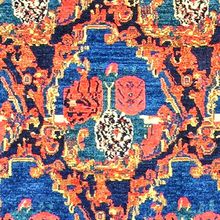Kurdi Rug
| Kurdi Rug | |
|---|---|
 Design of Kurdi Rug (Rugman) | |
| General information | |
| Name | Kurdi Rug |
| Original name | قالی کردی |
| Alternative name(s) | Kurdi Carpet |
| Origin | |
| Category | Tribal, Village, City |
| Technical information | |
| Common designs | Geometric, Buteh, Herati (Fish), Lacahk Toranj, Tribal |
| Common colors | Red, Blue, Navy Blue, Beige, Cream, Camel |
| Dyeing method | Natural, Synthetic |
| Pile material | Wool |
| Foundation material | Cotton, Wool, Silk |
| Knot type | Syemmetrical (Turkish), Asyemmetrical (Persian) |
History
Kurd Carpets Kurd tribes live across thousands of square miles in the Middle East, concentrated in eastern Anatolia (Turkey), northeastern Iraq, Syria, and Kurdistan in northwestern Iran. The Kurd population is estimated to be twenty-five million people worldwide. Over the centuries many empires and tribes conquered the Kurd region, among them the Tatars, Turkmens, Seljuks, Armenians, and Circassians (Cherkes). The Kurds, however, were strong fighters and were able to force out foreign occupiers to maintain their culture and nationality.
The weaving background of the Kurdish people traces back 3,500 years. They first made looms in order to weave tents and clothing. Kurd rugs and carpets from at least the early eighteenth century are known in the market. The Kurd population has three different identifiable weaving groups: the sem-inomadic, the village, and the city weaver.[1]
Materials
Foundation and Pile
Kurdish seminomadic weavings are generally coarse in grade quality, with a wool foundation and a wool pile.[2]
Techniques and structures
Color and dyeing
Undyed natural white, brown, and black wool also appear in these weavings.[3]
Motifs and Designs
Kurd seminomadic rugs have geometric and primitive designs in either medallion or allover styles. Nomadic designs, Star and stylized Hook motifs, and flower heads surround the major field patterns. Often, animals and birds are woven in the background and borders. Only in Anatolia (Turkey) did seminomadic weavers create Mihrab (prayer arch) designs.[4]
Weaving techniques
All solely employ the Turkish (symmetric) knot. Kurd seminomadic weavings are made for personal use and for sale in the markets. Flatwoven Kilim rugs, tribal items, small bags, and rugs in sizes up to approximately eight feet by five feet are made.[5]
See also
References
Bibliography
- Abraham Levi Moheban, (2015), The Encyclopedia of Antique Carpets: Twenty-Five Centuries of Weaving, NewYork: Princeton Architectural Press.